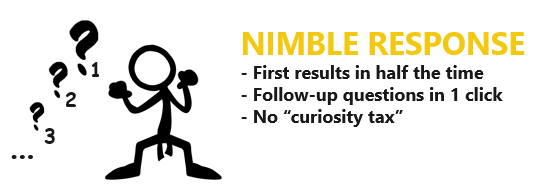Benefits of modern analytics
You and your organization can experience daily benefits from modern analytics capabilities, such as auto refresh, nimble response, splice sources, and capacity and speed. Additionally, these tools provide you with a competitive edge when you're working with data.
The following sections examine these daily benefits in depth.

It's often time-consuming to maintain your existing, traditional Excel spreadsheet reports and keep them up to date with the latest data. This labor-intensive process results in businesses frequently having to act on stale information while simultaneously consuming the analyst's time, limiting innovation and prohibiting real analysis. Auto refresh capabilities help you keep data up to date without the need for manual labor. Therefore, rather than expending extra effort, you can focus on driving data insights, actions, and real business outcomes.

New reports take less time to build. An analyst might spend hours working on a report and deliver precisely what was asked for. Then, be asked a follow-up question that requires a complete rebuild of the traditional Excel spreadsheet. Contrarily, modern analytics lets you answer follow-up questions with a single click, requiring no time and effort to rebuild. This feature is beneficial, considering that most people aren't certain about what they need until they physically see what they've asked for. Well-built solutions that use modern analytics provide speedy results and near-limitless answers to follow up questions. They empower nimble responses to an organizations' most challenging business questions.

Most businesses run on multiple systems. The most valuable business questions aren't specific to one silo or system. For example, answering the question, "What is our cash flow forecast for 90 days from now?" might require information from CRM, accounting, and other systems.
Power Query connects to data from disparate business systems and sources to splice, integrate, and shape data to create data models, resulting in end-to-end visibility across your business. Traditional Excel wasn't built to provide that ability.

Modern Excel has near-limitless data capacity. Traditional Excel is limited to 1 million rows of data for each sheet but is often slow before you reach 1 million rows. When you use Excel with Power Query, Data Model, and Power BI, it routinely handles tens of millions of rows while recalculating in a fraction of the time. This capability unlocks usage patterns that people might not consider in regular Excel. Such as, loading multiple years' worth of data into a single workbook rather than starting a new workbook each month. This approach saves you time while allowing you to perform analyses that you might not have imagined possible.